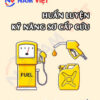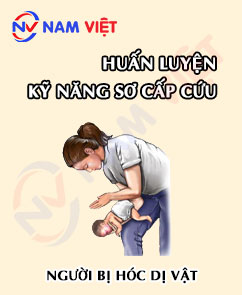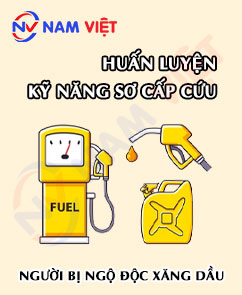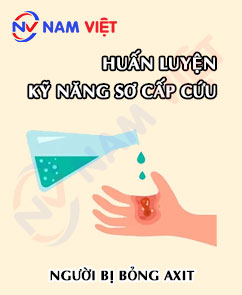First aid training for individuals poisoned by sleeping pills poisoning
500,000 ₫
Note: The above price is calculated per person. Prices may vary depending on the number of participants in the course and market fluctuations. For more accurate pricing, please refer to the price list or contact our consulting staff directly.
Table of Contents
Toggle1. Identifying a Person with Sleeping Pill Poisoning
a. Cases of sleeping pill poisoning
Sleeping pill poisoning is a dangerous condition that requires immediate intervention. Here are some common cases of sleeping pill poisoning:
- Loss of consciousness: The victim may become unconscious, unresponsive, or have difficulty opening their eyes.
- Slow breathing: The victim may breathe slowly, irregularly, or temporarily stop breathing.
- Pale lips and skin: The victim’s lips and skin may become pale and lose color.
- Nervous system symptoms: The victim may experience seizures, trembling, imbalance, or difficulty controlling their body.
- Vomiting: The victim may vomit or show signs of blood in the vomit.
- Low blood pressure: Blood pressure may drop to low levels, causing dizziness, lightheadedness, or weakness.

b. Signs indicating someone is at risk of sleeping pill poisoning
Several signs can indicate that someone is at risk of sleeping pill poisoning. Key signs include:
- Excessive fatigue and sleepiness: The victim may feel extremely tired and drowsy, even having difficulty staying awake.
- Unusual or abnormal behavior: The victim may show unusual behavior, such as drowsy speech, hesitation, or not responding appropriately to situations.
- Confusion or memory loss: The victim may be confused or have difficulty remembering recent events.
- Changes in breathing and heart rate: Breathing may slow, and heart rate may decrease.
- Visual signs: The victim may experience blurred vision, difficulty focusing, or trouble seeing clearly.
- Nervous system signs: Symptoms may include trembling, seizures, imbalance, or difficulty controlling movements.
- Slow or stopped breathing: In severe cases, the victim may temporarily stop breathing or have irregular, slow respiration.

c. Assessing the condition of a victim of sleeping pill poisoning
Assessing the condition of a sleeping pill poisoning victim is complex and should only be done by qualified medical personnel. Based on common symptoms, some possible conditions include:
- Loss or decreased consciousness: The victim may lose consciousness or have significantly reduced awareness, being unresponsive or difficult to wake.
- Slow or temporary stopped breathing: The victim may breathe slowly, irregularly, or stop breathing temporarily.
- Nervous system symptoms: The victim may experience trembling, seizures, imbalance, or difficulty controlling movements.
- Pale lips and skin: The victim’s lips and skin may appear pale, discolored, or show cyanosis (bluish-gray color due to lack of oxygen).
- Vomiting: The victim may vomit or show signs of blood in the vomit.
- Low blood pressure: Blood pressure may drop, causing dizziness, lightheadedness, or weakness.

d. Golden time for sleeping pill poisoning cases
Sleeping pill poisoning is an emergency that requires immediate intervention. The golden time, which is the critical period to provide first aid, is essential to reduce complications and increase survival chances. The golden time may vary depending on the situation, but the following measures should be taken immediately:
- Call emergency services: Dial the emergency number (e.g., 115) immediately and inform them about the sleeping pill poisoning. Emergency staff will provide guidance and assistance.
- Remove the source of poisoning: If possible, remove the cause of poisoning. For example, if the victim ingested pills, try to induce vomiting or collect a sample of the pills to provide to medical personnel for treatment reference.
- Support breathing: Ensure the victim’s airway is clear. If the victim stops breathing, perform cardiopulmonary resuscitation (CPR) if trained.
- Place the victim in a recovery position: Lay the victim on their side to ensure the airway remains open.
Note that the golden time is critical, and calling emergency services immediately is essential in cases of sleeping pill poisoning.

2. Overview of first aid training for sleeping pill poisoning
a. What is a first aid training course?
A first aid training course is a program designed to help learners master basic and advanced first aid skills. The program includes lessons and practical exercises on handling emergencies such as cardiac arrest, respiratory failure, poisoning, injuries, and other urgent situations.
The purpose of the first aid training course is to equip learners with the skills needed to respond to emergencies, minimize harm to themselves and others, and increase survival chances while ensuring timely transfer to medical facilities.
REGISTER FOR BASIC FIRST AID TRAINING
b. Training duration
Initial first aid training:
- For employees: 4 hours.
- For first aid and emergency responders: 16 hours (2 days).
Periodic first aid training:
- For employees: 2 hours.
- For first aid and emergency responders: 8 hours (1 day).
c. Course content
- Basic principles of first aid and on-site emergency care
- Wound bandaging (principles, tools, techniques)
- Temporary bleeding control techniques (principles and methods)
- Temporary fracture stabilization techniques (principles and tools)
- Cardiopulmonary resuscitation (recognizing signs of cardiac arrest, airway clearance, breathing support, CPR guidance)
- Burn management (assessing cause and severity, on-site first aid)
- Safe victim transportation with and without stretchers for initial care
- Specific emergency care scenarios:
- Electric shock
- Drowning
- Chemical accidents
- General guidance on first aid kit use
- Practical exercises for all content areas
d. First aid training certificate
Upon completing the course, learners will receive a certificate confirming completion of the first aid training program under the Group 2 training framework as specified in Appendix IV, Decree 44/2016/ND-CP. The certificate is valid for 1 year.


3. Essential Tools in a First Aid Kit for Sleeping Pill Poisoning
In a first aid kit, there are several essential tools to assist in providing first aid in cases of sleeping pill poisoning. Below are some important tools:
- Mobile phone: To call emergency services and contact medical personnel.
- Respiratory rescue kit: Includes a rescue mask, safety goggles, and medical gloves to protect yourself when handling toxins.
- Helmet: To ensure the safety of the rescuer and the victim.
- Flashlight: To provide light during emergencies, especially at night or in low-light environments.
- Bandages and adhesive tape: Used to dress minor wounds or stabilize injured areas.
- Scissors: Used to cut clothing or belts if necessary to perform first aid.
- Toxin suction kit: Used to remove toxins from the victim’s mouth and throat.
- Thermal helmet: Used to keep the victim warm during the rescue process.
- CPR mask: Used to provide artificial respiration in case of cardiac or respiratory arrest.
- Ice packs or cold packs: Used to reduce inflammation or pain caused by poisoning.
REGISTER FOR BASIC FIRST AID TRAINING
4. First Aid Procedure for Sleeping Pill Poisoning
Providing first aid for sleeping pill poisoning is a critical task and must be carried out immediately. Below is an overview of the procedure:
- Call emergency services: Immediately dial emergency numbers (such as 115) to request professional medical assistance. Report the sleeping pill poisoning and provide necessary information.
- Ensure safe movement: Ensure the safety of yourself and the victim. If the environment is hazardous (e.g., toxic gases, fire), make sure both you and the victim are safe before performing first aid.
- Check breathing: Assess the victim’s breathing. If they are not breathing or show signs of distress, start cardiopulmonary resuscitation (CPR).
- Remove toxins: If toxins remain in the victim’s mouth, carefully remove them using gloves and cotton swabs or a toxin suction kit (if available). Do not attempt this if not trained.
- Keep the airway open: Place the victim in a lateral (side-lying) position to ensure the airway remains clear. Check for any obstructions and remove them if present.
- Keep warm and limit toxin absorption: Wrap the victim in a blanket or warm clothing. Do not allow the victim to eat or drink unless instructed by medical personnel.
- Monitor and wait for medical personnel: Continue monitoring the victim’s condition and wait for professional medical assistance.
5. Benefits of First Aid Training
First aid training provides many important benefits for individuals and communities:
- Saving lives in critical situations: First aid skills enable trainees to save someone whose life is at risk, such as in cases of cardiac arrest, respiratory arrest, poisoning, injuries, and other emergencies.
- Helping others learn first aid: Trained individuals can share their knowledge and experience with others, helping the community protect itself and reduce mortality in emergency situations.
- Reducing rescue waiting time: Trained first aiders can handle emergencies on-site, minimizing the time waiting for rescue teams to arrive.
- Enhancing response and reducing stress in emergencies: First aid training helps learners respond accurately and quickly, reducing pressure and anxiety while waiting for help.
- Increasing survival rates and reducing fatalities: Timely and proper first aid increases survival chances and reduces the risk of complications or death in emergency situations.

6. First Aid Training Capacity of An Toan Nam Viet
An Toan Nam Viet is a reputable and high-quality first aid training center in Vietnam. It conducts continuous training sessions at manufacturing workshops, factories, and construction sites nationwide (all 63 provinces of Vietnam).
REGISTER FOR BASIC FIRST AID TRAINING
Training Certification
- An Toan Nam Viet has been inspected and certified by the Department of Safety under the Ministry of Labor – Invalids and Social Affairs, granting certification to conduct occupational safety and hygiene training. Within the Group 2 training program, the first aid skills module is included, further strengthening our capacity in first aid training.

Training Materials and Lectures
- Before first aid training materials are used in first aid courses, they are reviewed to ensure accuracy and practical effectiveness.
- Instructors’ teaching methods are standardized according to An Toan Nam Viet standards, developed by experts in first aid training to maximize knowledge retention for trainees.
Facilities
- Controlling factors in the training room enhances teaching efficiency and knowledge absorption.
- Our training facilities provide spacious classrooms meeting standards for space, lighting, and training equipment, etc.
7. Nationwide First Aid Training Centers
An Toan Nam Viet is one of the most reputable and professional organizations for first aid training in Vietnam. With experienced instructors, modern equipment, and high-quality programs, the center has become an ideal destination for those interested in protecting lives and health.
By participating in courses at An Toan Nam Viet, you will learn basic and advanced first aid skills, including CPR for cardiac arrest, respiratory arrest, poisoning, injuries, and other emergency situations. The program is flexible and suitable for all learners, from adults to children, medical staff, rescue personnel, and the general public.
An Toan Nam Viet’s first aid training not only teaches essential life-saving skills but also fosters awareness to protect your own life and health as well as those around you. Training by experienced and highly qualified instructors ensures confidence and readiness for any emergency situation.
Register for first aid courses at An Toan Nam Viet to protect your life, health, and the community.
1 review for First aid training for individuals poisoned by sleeping pills poisoning
No comments yet












maituyet.cuong12
Good first aid training center! Satisfied